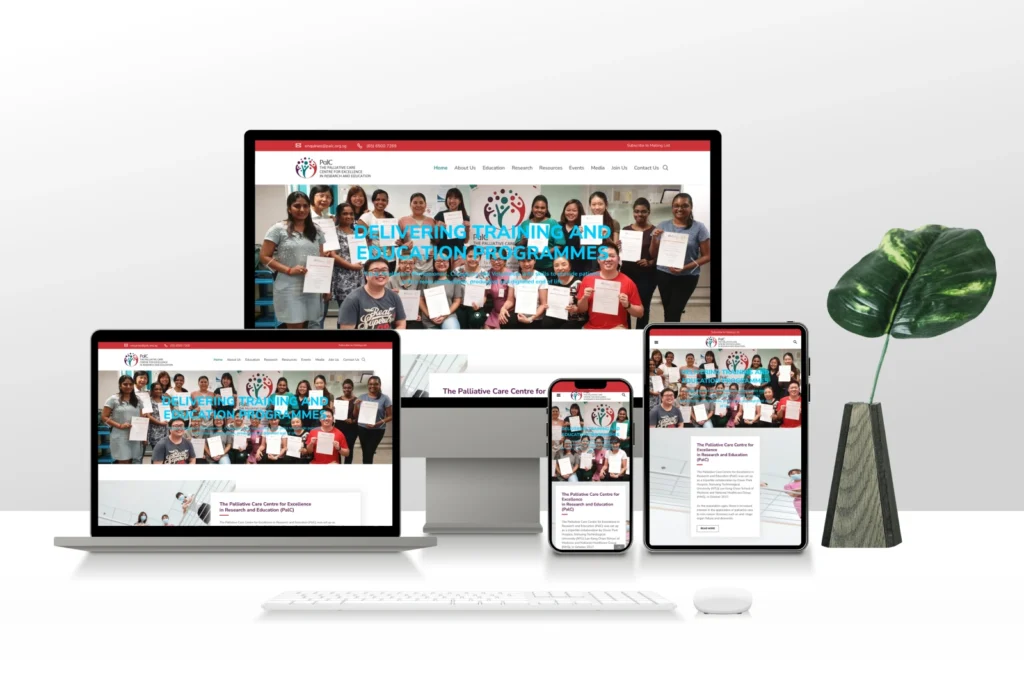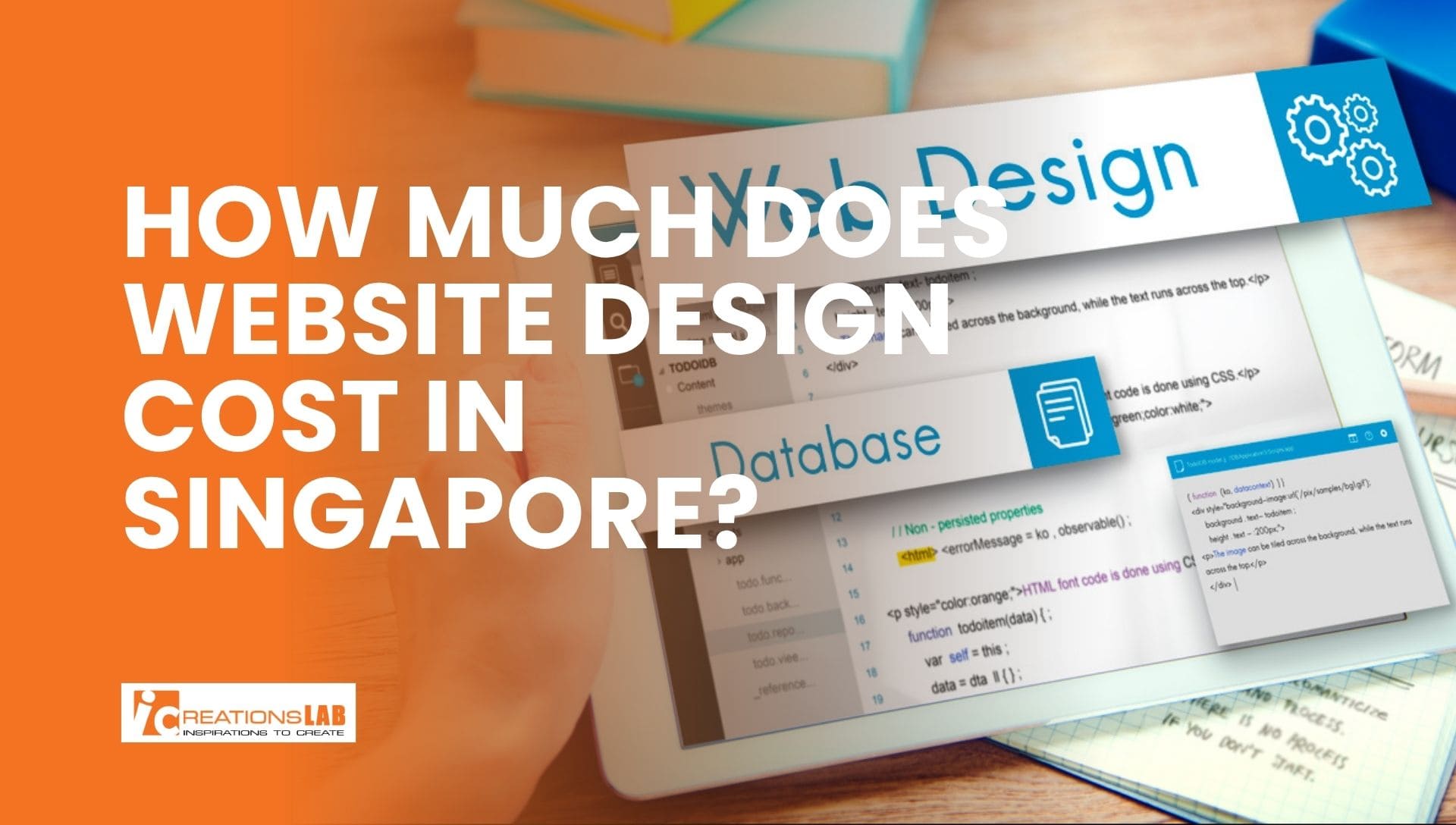In the digital-first world of 2025, having a professionally designed website is no longer optional—it’s essential. Whether you’re a startup, SME, or established brand in Singapore, a well-crafted website plays a key role in driving business success. But one of the most common questions business owners ask is: How much does website design cost in Singapore?
In this complete guide, we’ll break down website design pricing, from basic brochure sites to advanced custom builds. We’ll also explain the factors that influence pricing, common website types, and tips for getting the best value from your investment.
1. Why Website Design Matters in 2025

Your website is often the very first impression potential customers have of your brand—think of it as your digital storefront. If it looks outdated or performs poorly, you could lose visitors before they even read about your products or services.
That’s why professional website design is so important. A well-designed website can:
- Build trust with visitors by looking polished and reliable
- Boost conversions by guiding users to take action, such as filling out a form or making a purchase
- Improve SEO, helping your site rank higher on Google
- Work flawlessly on all devices, from smartphones to desktops
In 2025, factors like Google’s Core Web Vitals and mobile-first indexing have made website speed, mobile usability, and overall design critical for both user experience and search engine rankings. Simply put—how your website looks and functions directly affects your online success.
2. What Influences Website Design Cost?

The cost of designing a website in Singapore can vary depending on a range of factors. Below are the most important elements that influence pricing:
a. Website Complexity
The size and structure of your website have a major impact on the overall design cost. A small business site with a few basic pages—such as Home, About Us, Services, and Contact—is relatively simple to design and build, making it a more affordable option. These types of websites typically focus on presenting information clearly without needing complex functionality.
However, as your website grows in size or requires more advanced features, costs will increase. A larger site with additional pages, custom content sections, or dynamic user experiences—such as member dashboards, booking portals, or online forums—demands more development time and planning.
E-commerce websites are even more resource-intensive. They require product listings, search and filter capabilities, shopping cart systems, secure payment gateways, and sometimes inventory integration. Each of these components adds layers of complexity, which directly contributes to a higher development budget.
b. Custom Design vs. Pre-made Templates
c. Content Creation
If you already have your website’s text, images, and videos prepared, you can significantly reduce your overall design costs. But if your web design provider needs to create this content for you—such as writing compelling copy, sourcing stock photos, or producing professional videos—expect your project cost to increase.
High-quality content plays a critical role in how your website performs. It ensures your message is clear, engaging, and aligned with your brand voice, helping to attract and retain visitors.
d. Features and Functionality
The more features your website requires, the more development time and expertise will be needed—raising the overall cost.
Common features that affect pricing include:
Booking or reservation systems
Online store capabilities (shopping cart, payment gateway, product filters)
User accounts or membership areas
Live chat and WhatsApp integration
CRM and email marketing tool connections
Embedded Google Maps or event calendars
Each of these elements adds complexity, especially when they need to be customized to fit your brand or user journey.
e. Experience and Reputation of the Provider
The cost of web design also varies depending on who you hire.
Freelancers and offshore developers usually offer lower prices, but their quality and reliability can vary widely. You may face challenges with communication, delays, or limited support.
In contrast, established web design agencies in Singapore charge more due to higher operating costs and a more comprehensive service model. However, they bring valuable expertise, structured processes, and deep knowledge of the local market. Their higher pricing often reflects better design quality, project management, and long-term support.
See More: Is It Time for a Website Revamp? Complete Guide in 2025
3. Common Types of Websites and Their Pricing Ranges
Understanding what type of website you need is key to estimating your budget. Below are the most common website types in Singapore and how much they typically cost in 2025
One-page Website
A simple landing page with minimal content
Perfect for limited-time promotions, events, or personal portfolios
Average cost: SGD $300 to $800
Basic Business Website
Usually includes 3 to 5 pages such as Home, About Us, Services, and Contact
Suitable for startups or SMEs that need an online presence
Average cost: SGD $800 to $2,500
Corporate Website
More comprehensive, typically 6 to 15 pages
May include case studies, blogs, team pages, and contact forms
Designed for growing businesses or professional service firms
Average cost: SGD $2,000 to $5,000
E-commerce Website
Includes product catalog, shopping cart, checkout system, and payment integration
May also feature inventory tracking, customer accounts, and promotions
Ideal for businesses selling products or services online
Average cost: SGD $3,000 to $10,000 and up
Custom Web Application
Highly specialized with custom-built features or workflows
Used for things like customer portals, booking systems, or multi-user dashboards
Requires more development time, testing, and planning
Average cost: SGD $10,000 to $50,000 or more
Note: These prices reflect common market rates in Singapore as of 2025. Your final cost may vary depending on features, design complexity, timeline, and service provider.
See More: Spring Clean Your Website: The Complete Guide to Better UX & SEO
4. Website Design Packages in Singapore – What Do You Get for Your Money?

If you’re thinking about hiring a web design company in Singapore, you’ll usually find three types of website packages. Each one offers different features depending on how simple or advanced you want your website to be.
Let’s break them down so you can understand what each package includes and how much it might cost.
Basic Package – Great for Small Projects or Startups
This is the starter option if you just need a simple website to get online
What’s included:
- Up to 5 pages (like Home, About, Services, Contact, Gallery)
- Uses a ready-made template (design is not 100% unique)
- Basic contact form so visitors can message you
- Works well on phones and tablets (mobile-friendly)
Estimated Cost: SGD $800 to $1,500
This is perfect for small businesses, personal blogs, or students creating a portfolio site
Standard Package – A Step Up with More Features
Choose this if you need a more professional site with better design and a bit more flexibility
What’s included:
- Around 5 to 10 pages
- Semi-custom design (you can change more things to match your brand)
- Basic SEO (helps Google find your website)
- Blog section or easy-to-edit content system (CMS) so you can update pages anytime
Estimated Cost: SGD $1,500 to $4,000
This is good for growing businesses or schools and organizations that want better visibility online
Premium Package – For Bigger Websites and Advanced Features
Go for this if your website needs to do more than just show information
What’s included:
- More than 10 pages
- Fully custom design made just for you
- Advanced tools like booking systems, customer relationship management (CRM), or support for multiple languages
- Website is optimized for fast loading and strong search engine performance
- Post-launch help like updates, fixes, or training
Estimated Cost: SGD $4,000 to $10,000 or more
This is perfect for large companies, online stores, or brands that want a high-quality digital presence
Summary
| Package | Best For | Estimated Cost |
| Basic | Simple websites or student use | $800 – $1,500 |
| Standard | Small to medium businesses | $1,500 – $4,000 |
| Premium | Large or complex websites | $4,000 – $10,000+ |
The more custom and powerful your website needs to be, the more it costs. But you also get more value and features with the higher packages.
See More: What Is a Website? A Beginner’s Guide
5. Extra Services That Can Add to the Cost of a Website
When you buy a website design package, not everything might be included in the base price. Some helpful services come as add-ons, which means you have to pay extra if you need them.
These extra services can make your website look more professional, perform better, and help people find it online—but they also add to the total cost.
Here’s a breakdown of common extras and what they usually cost in Singapore (in SGD):
Logo Design & Branding – $300 to $2,000
If you don’t already have a logo or brand style, a designer can help you create one. This includes choosing your brand’s colors, fonts, and overall look so your website feels unique and professional.
Copywriting – $200 to $1,500
Don’t know what to write on your site? No worries. A copywriter can create all your website text, like your About page, service descriptions, or blog posts. The better the writing, the more your site will connect with visitors.
Stock Images or Photography – $100 to $1,000+
Good visuals matter. You can buy stock photos (professional images from online libraries), or you can hire a photographer to take pictures of your team, office, or products. Custom photos often cost more but feel more authentic.
E-commerce Setup – $500 to $5,000
If you want to sell products online, you’ll need features like a shopping cart, checkout page, and payment system. The more products and options you need, the more it will cost to set up.
Web Hosting & Maintenance – $150 to $1,000 per year
Once your site is live, it needs a place to live (called hosting) and someone to keep it updated (maintenance). This might include fixing bugs, updating plugins, or renewing your domain name.
SEO Optimization – $500 to $3,000+
SEO (Search Engine Optimization) helps people find your website on Google. An SEO expert can improve your keywords, page speed, and structure to boost your chances of ranking higher.
Summary Table
| Extra Service | What It’s For | Estimated Cost (SGD) |
| Logo & Branding | Create a unique look and feel | $300 – $2,000 |
| Copywriting | Writing the text on your website | $200 – $1,500 |
| Stock Images/Photography | Add visuals to make the site attractive | $100 – $1,000+ |
| E-commerce Setup | Online store features (cart, payment, etc.) | $500 – $5,000 |
| Hosting & Maintenance | Keep your website online and updated | $150 – $1,000 per year |
| SEO Optimization | Help your site rank better on search engines | $500 – $3,000+ |
6. How to Save Money on Website Design (Without Losing Quality)
Designing a great website doesn’t always mean spending a lot of money. With smart choices, you can build a professional-looking site that fits your budget. Here are some practical tips to help you save:
Start Small, Grow Later
Instead of trying to build a big, complex site all at once, focus on the most important pages first—like Home, About, and Contact. You can always add more pages and features when you have more time or money.
Use a Popular Website Platform Like WordPress
WordPress is a content management system (CMS) that powers millions of websites. It’s free, flexible, and has tons of pre-built themes and plugins. This saves time and money compared to building a site from scratch.
Create and Provide Your Own Content
If you can write your own text or take your own photos, you won’t have to pay someone else to do it. Just make sure your writing is clear and your images are good quality.
Choose a Template-Based or Hybrid Design
Instead of a fully custom design, you can use a template (pre-designed layout). Some designers also offer hybrid solutions, where they start with a template and tweak it to match your brand. This gives you a nice-looking site at a lower cost.
Request Payment in Stages
Ask the designer or agency if you can pay in milestones, such as 30% at the start, 30% halfway through, and the rest at the end. This helps you manage your budget better and reduces financial stress.
7. How to Choose the Right Web Design Partner

Picking the right person or company to design your website is important. A good web designer will not only make your site look great but also help it work well and attract visitors.
Here are the key things to check before making a decision:
Look at Their Portfolio
A portfolio is a collection of websites they’ve built before. Visit those websites and ask yourself:
- Do they look professional?
- Are they easy to use?
- Do they match the style you’re looking for?
Read Reviews and Testimonials
Check Google reviews or ask for feedback from past clients. Positive reviews show the designer is reliable and delivers good results. Watch out for complaints about delays, poor communication, or hidden costs.
Understand Their Process
Ask how they build websites. A good designer will usually offer:
- A strategy or plan before starting
- A wireframe (a simple layout preview)
- Revisions to improve the design
- Testing to make sure everything works
Ask About Support After Launch
Once your website is live, will they help you fix bugs, update content, or keep things secure? Choose someone who offers post-launch support so you’re not stuck later.
Make Sure They’re Transparent
A trustworthy designer should give you clear pricing and a list of what’s included. There should be no hidden fees or confusing terms.
8. Red Flags to Watch Out For
Before hiring someone to design your website, watch for warning signs that something might not be right. A low price or quick promise isn’t always a good deal.
Here are common red flags to avoid:
No Contract or Confusing Terms
If they don’t give you a written contract or their terms are unclear, it’s a sign you may not be protected if something goes wrong. Always get the details in writing.
Prices That Seem Too Good to Be True
Super cheap prices often mean poor quality or hidden costs later. A well-built website takes time and skill, so it’s okay to pay for professional work.
No Portfolio or Past Work
If they can’t show examples of websites they’ve built before, you have no way to judge their ability. Always ask to see past projects.
Poor Communication
If they take too long to reply, give vague answers, or don’t seem to understand what you want, it’s a bad sign. Good designers should explain things clearly and respond quickly.
Hidden Fees or Unclear Deliverables
If the price isn’t clear or they don’t explain exactly what you’re getting, be cautious. You should know upfront what is included in the price and what costs extra.
See More: Is Your Website Secure? Protect It With Smart Maintenance
Ready to Build or Revamp Your Website?
At iCreationsLab, we specialize in high-performing, SEO-optimized websites tailored for Singapore businesses.
Free consultation
Mobile-first designs
Transparent pricing
+ Contact us at +65 6269 9558
+ Email: [email protected]
Let’s turn your digital presence into a business asset.

